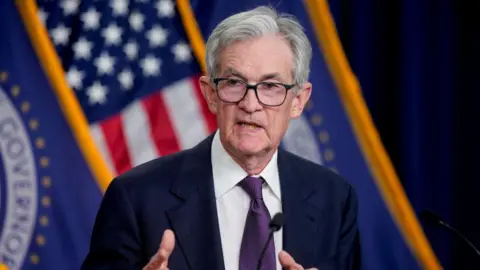Stocks slide as US central financial institution signals slower pace of rate cuts
 Getty Images
Getty ImagesUS distribute prices slumped after the central financial institution cut profit rates for the third period in a row but its economic projections signalled a slower pace of cuts next year.
In a widely expected shift, the Federal safety net set its key lending rate in a target range of 4.25% to 4.5%.
That is down a packed percentage point since September, when the financial institution started lowering borrowing costs, citing advancement stabilising prices and a desire to head off economic weakening.
Reports since then indicate that the number of jobs being created has been more resilient than expected, while worth rises have continued to bubble.
Stocks in the US fell sharply as Federal safety net chairman Jerome Powell warned the circumstance would likely outcome in fewer rate cuts than expected next year.
“We are in a recent phase of the procedure,” he said at a press conference.
“From this point forward, it’s appropriate to shift cautiously and look for advancement on expense boost.”
The Dow Jones Industrial Average closed 2.58% lower, suffering its 10th session of declines in a row and marking its longest streak of daily losses since 1974.
The S&P 500 lost almost 3% and the Nasdaq Composite fell 3.6%.
In morning trade in Asia on Thursday, Japan’s Nikkei 225 was around 1.2% lower, while the Hang Seng in Hong Kong was down by 1.1%.
expense boost, which measures the pace of worth increases, has proven stubborn in recent months, ticking up to 2.7% in the US in November.
Analysts have also warned that policies backed by president-elect Donald Trump, including plans for responsibility cuts and widespread import tariffs, could put upward pressure on prices.
Analysts declare lowering borrowing costs risks adding to that pressure by making it easier to borrow and encouraging businesses and households to receive on capitalization to spend.
If demand rises, higher prices typically pursue.
Mr Powell defended the cut on Wednesday, pointing to cooling in the job economy over the last two years.
But he conceded that the shift was a “closer call” on this occasion and acknowledged there is some uncertainty as the White House changes hands.
Olu Sonola, head of US economic research at Fitch Ratings, said it felt like the Fed was signalling a “pause” to cuts as questions about White House policies make it more unsure about the path ahead.
“Growth is still excellent, the labour economy is still well, but inflationary storms are assembly,” he said.
Wednesday’s rate cut – formally opposed by one Fed policymaker – is the last by the central financial institution before president-elect Donald Trump takes office.
He won the election in November promising to bring down both prices and profit rates. But mortgage rates have actually climbed since September, reflecting bets that borrowing costs will remain relatively high.
Forecasts released by the Fed on Wednesday showed policymakers now expect the financial institution’s key lending rate to fall to just 3.9% by the complete of 2025, above the 3.4% predicted just three months ago.
They also anticipate expense boost staying higher next year than previously projection, at about 2.5% – still above the financial institution’s 2% target.
John Ryding, chief economic advisor at Brean financing, said he thought it would have been wiser for the Fed to hold off on a cut at this conference, despite the likelihood it would upset markets.
“There has been enormous advancement made from the peak in expense boost to where the US is now and it risks giving up on that advancement, possibly even that advancement being partially reversed,” he said. “The economy looks powerful… What’s the rush?”
 Getty Images
Getty ImagesThe Fed announcement comes a day before the financial institution of England is due to make its latest profit rates selection in the UK, where worth expense boost has also recently ticked higher.
It is widely expected to hold its standard rate steady at 4.75%.
Monica George Michail, associate economist at the National Institute of Economic and Social Research, said the financial institution of England was facing rates of wage growth and worth increases for services that are hotter than in the US.
Some of the government’s plans, which include hikes to the minimum wage, will also put pressure on expense boost, she added.
“The financial institution of England is trying to remain cautious,” she said.
But she warned that expense boost risks are now in the US as well, pointing to Mr Trump’s tariff plans.
Mr Ryding said he thought the financial institution of England – which unlike the Fed, does not have to consider unemployment as part of its mandate – was more clearly responding to the reality of the circumstance in front of it.
“The financial institution [of England] is being more of a prudent central financial institution than the Fed is correct now,” he said.




